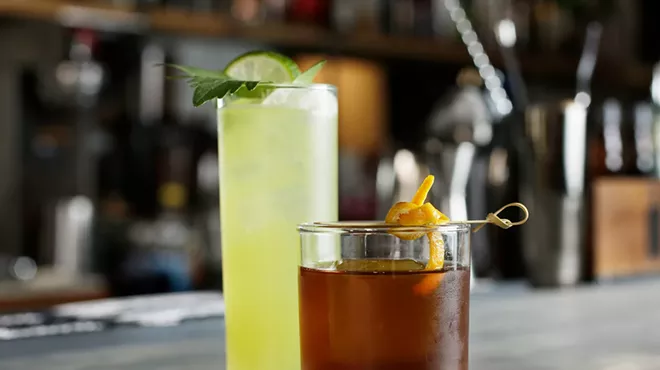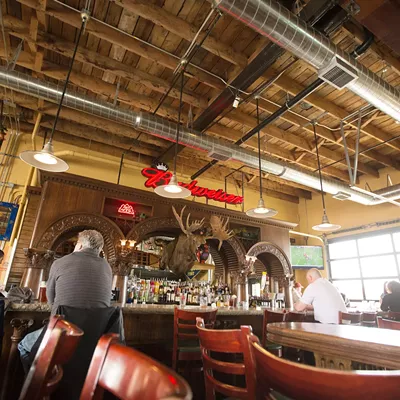Spokane and the Inland Northwest has a robust brewing scene. Yet, even with the continual rise of craft breweries, their regional sales don't even come close to that of macrobreweries. Brands like Budweiser, Corona and Guinness dominate sales around the globe. That's lame. Here at the Inlander, we truly believe local is better. That's why I want to suggest a few alternatives to those national corporations and even some of the regional giants. From downtown Spokane to Spokane Valley, here are several offerings that will have your palate thanking you.
If you like Budweiser, Coors Banquet or Miller High Life, try...
BRICK WEST BREWING'S MY TOWN
I'm not here to debate which of the three American lager giants are better. Their respective breweries share similar stories and have been in the business since the 1800s. But the beer you're drinking today isn't what was brewed by the German immigrants who helped start them. At one point these lagers may have resembled their European counterparts, but today they boast significantly less body and flavor than traditional Pilsners. Hey, I'm not knocking them. There's a time and place for a Coors Banquet (5% ABV), and people clearly like them.
Still, we can all agree that there are better options, even in the American lager category. Locally, you can just head to downtown Spokane's Brick West Brewing Co. Their flagship My Town American lager (4.8%) is exactly what you wish High Life (4.6%) tasted like. Highly quaffable with a pleasant floral aroma, it's hopped exclusively with Contessa — a cross between the classic American hops Fuggle and Cascade. It also boasts a crispness like none other.
"We only use natural carbon dioxide derived from fermentation to carbonate My Town, a process known as spunding," says head brewer Scotland Shouse. "Spunding allows us to create a crisp-ending beer that falls softly onto the palate."
I'd say the king of beers has a challenger to the throne, but there's really no contest here.
If you like Corona, try...
GARLAND BREW WERKS' LADO NORTE
We could've picked any commercial Mexican lager here. Modelo, Pacifico, Tecate, they're all pretty similar. But Corona Extra (4.6%) is the most widely sold in the states. Owned by the same company that produces Budweiser (Anheiser-Busch InBev), Corona was nearly synonymous with backyard barbecues at one point. While there's no official definition of a Mexican lager, it's commonly brewed with corn in addition to malted grain. It lands somewhere between the heaviness of European exports and the ultra light American lagers.
It's not too difficult to find a craft replacement, especially this time of year. I suggest sippin' on Garland Brew Werks' Lado Norte (5%) at your next sunshine-filled shindig. Translating to "north side" in English, this Mexican lager is brewed with a blend of Pilsner malt and flaked corn. Head brewer Adam Boyd describes the beer as very traditional as far as recipes go, but with one craft-brewer twist.
"I use Motueka hops to give it a distinct lemon-lime character," Boyd says.
That's a nice alternative to serving the beer with a lime wedge.
If you like Guinness, try...
COMMON LANGUAGE BREWING'S PADDY O'FURNITURE
Ireland's No. 1 export comes in a few shapes and sizes. The kind of pint you'll most likely find at Irish pubs throughout the world is simply known as Guinness Draught (4.2%). Typically served on nitro, the creamy stout has notes of sweet malt and coffee. Its big brother is Guinness Extra Stout (5.6%). The bottled relative is similar to Guinness Draught, but with a bit more hops and a higher alcohol content.
This is exactly what Common Language Brewing Company is aiming for with Paddy O'Furniture. Landing between Guinness Draught and Extra at 4.9% ABV, the Irish stout was on the debut lineup at the newly opened downtown Spokane brewery. It's brewed with local LINC English Pale malt and malted oats, as well as the traditional roasted barley. Head brewer and co-owner Charlie Thudium says he's been getting a lot of good feedback on Paddy O'Furniture from the community, but he already has a couple of slight tweaks in mind for the next batch.
"It's just an easy-drinking, low-alcohol dry Irish Stout, and people are really loving that," Thudium says.
If you like Sierra Nevada Pale Ale, try...
TT'S OLD IRON BREWERY'S MAX PALE
Sierra Nevada's Pale Ale (5.6%) is the gateway beer to craft. I remember opening the fridge in my college apartment and seeing nothing but the green case of 12-ounce bottles and a few condiments. The beer was created by the revolutionary California craft brewery in 1980 and solely hopped with Cascade hops. It's a simple concept — load a pale ale with hops, but keep it easy drinking.
Sure, Sierra Nevada Pale Ale is still considered great by today's standards, but I suggest skipping the beer aisle on your next trip to the grocery store. Instead, head out to Spokane Valley and try the Max Pale Ale (5.2%) from TT's Old Iron Brewery and BBQ.
"We brewed Max Pale to be a hoppy beer that is bitter enough to be interesting while still balanced enough to earn a repeat pour or two," says head brewer Rachel Nalley.
Pale malt gives this beer a light base, then Vienna and Munich malts add a slight sweetness and color. Generous amounts of Cascade, Comet and Centennial hops bring out a balance of pine and citrus aromas. Nalley says the beer is "equally welcoming to an IPA or a blonde drinker."
If you like Elysian Space Dust IPA, try...
LUMBERBEARD BREWING'S WHAT ONCE WAS
Found anywhere from dive bars to fancy restaurants to regional sporting events, Space Dust (8.2%) might be the most popular IPA in the Pacific Northwest. Seattle's Elysian Brewing Company started out as a local spot in the mid-'90s and has been making the double IPA for a decade. Things have changed since. The brewery eventually grew into a Goliath and was bought in 2015 by AB InBev — yup, the same makers of Budweiser and Corona. So if you care about that sort of thing, it's no longer considered craft beer. You know what is? Every beer made in the Inland Northwest.
Lumberbeard Brewing in downtown Spokane is one of those local breweries, and they excel at making classic West Coast double IPAs. Do yourself a favor and make a trip to their taproom next time you're craving those dank hop bombs.
The names and recipes change with each batch, but their current offering is known as What Once Was (8.3%). It's brewed entirely with locally grown malt. A mix of Citra, Idaho 7, Simcoe and Columbus hops create a grapefruit and melon nose.
Lumberbeard owner and head brewer Bret Gordon describes What Once Was as "fairly light bodied with a nice bitterness and super-dry finish."
"Drinks way too easy for 8.3% ABV," he adds.
If you like Widmer Brothers Hefe, try...
WHISTLE PUNK BREWING'S HEFEWEIZEN
Drive around town and you'll most likely find some billboards for Widmer Hefe (4.9%). Widmer Brothers is another one of those used-to-be-craft breweries. They joined the Craft Brew Alliance a few years ago, which was then acquired by AB InBev in 2020 (sigh). Their cloudy flagship was introduced in 1984 and is pretty easy drinking. But it isn't the best example of a traditional hefeweizen — a German ale that quite literally translates to "yeast wheat." I mean, Widmer Hefe is considered an American-style version, after all.
Spokane is home to a good example of the beer style. Just take a look at Whistle Punk Brewing. Based in Newman Lake with a downtown Spokane taproom, the brewery takes pride in their German and broadly European-style beers.
"Our hefeweizen is brewed as traditional as we can make it," owner and head brewer Matt Hanson says.
Whistle Punk Hefeweizen (4.8%) is brewed with 50 percent Bavarian wheat and is hopped with the German Hallertau Mittelfrüh. The yeast is what really shines through in this style, though. In one sip you'll get notes of banana, vanilla and clove. Hanson says this is what makes his beer and other true Bavarian hefes stand out.
"Many American hefeweizens should really be classified as American wheat ales," Hanson says. "They are void of character and use neutral yeast strains which do not express any of the flavors that define the hefeweizen style."
If you like Mac & Jack's African Amber, try...
YAYA BREWING'S THE DEPARTED
Unlike Elysian and Widmer Brothers, Mac & Jack's Brewing Company is an independent craft brewery. It's over on the west side of Washington in Redmond and brews the popular African Amber Ale (5.8%). They make more than that, but I can cut you some slack if you can't name any others. The unfiltered amber is easily their signature ale.
For something a bit more local, YaYa Brewing Company has you covered. The Departed Amber Ale (6.2%) is brewed in Spokane Valley, and it's a more complex variation on the style. YaYa combines grains from three different countries to create a malty profile of dried fig and roasty caramel. Its base LINC Genie Pale — malted in Spokane Valley — is joined by speciality malts from the U.K. and Belgium.
"These malts, in combination with Cascade hops, come together to form what we think is an approachable, albeit less hoppy, amber," says co-owner and head brewer Chris Gass. ♦





























